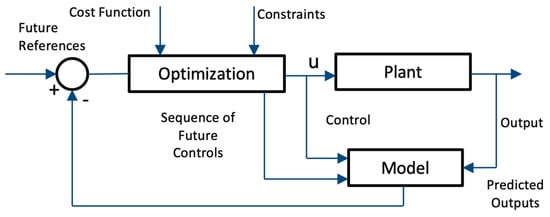The development of control techniques in smart grids has its origins mainly in the need to mitigate network failures and changes in power quality. The foregoing is due to economic concerns and the environmental impacts of energy issues in terms of sustainable development. Smart Grids have also contributed to the development and integration of renewable energies into the distributed system since this type of generation source presents intermittent output. These intermittency characteristics of renewable sources and the stochastic behavior of demand make these networks complex systems with types of non-linear control that must be robustly modeled, analyzed, tested, and implemented when considering their operation, safety, reliability, and maintenance. The above shows that the best ally of renewable energy sources is Smart Grids.
- smart grids
- renewable energy
- control systems
1. Rule-Based Control (RBC)

2. Optimal Control (RBC)

3. Agent-Based Modeling (ABM) Control
4. Model-Based Predictive Control (MPC)

5. Control Based on Discrete Event Models (CMEDS)

References
- Shakeri, M.; Shayestegan, M.; Abunima, H.; Reza, S.M.S.; Akhtaruzzaman, M.; Alamoud, A.R.M.; Sopian, K.; Amin, N. An intelligent system architecture in home energy management systems (HEMS) for efficient demand response in smart grid. Energy Build. 2017, 138, 154–164.
- Parejo, A.; Sanchez-Squella, A.; Barraza, R.; Yanine, F.; Barrueto-Guzman, A.; Leon, C. Design and Simulation of an Energy Homeostaticity System for Electric and Thermal Power Management in a Building with Smart Microgrid. Energies 2019, 12, 1806.
- Yanine, F.; Sanchez-Squella, A.; Barrueto, A.; Cordova, F.; Sahoo, S.K. Engineering Sustainable Energy Systems: How Reactive and Predictive Homeostatic Control Can Prepare Electric Power Systems for Environmental Challenges. Procedia Comput. Sci. 2017, 122, 439–446.
- Keshtkar, A.; Arzanpour, S.; Keshtkar, F. Adaptive residential demand-side management using rule-based techniques in smart grid environments. Energy Build. 2016, 133, 281–294.
- Miyano, T.; Hatanaka, T.; Fujita, M. Distributed Predictive Control and Estimation for Systems with Information Structures Exemplified by Control of Smart Grid. IFAC Proc. Vol. 2009, 42, 180–185.
- Ahmad Khan, A.; Naeem, M.; Iqbal, M.; Qaisar, S.; Anpalagan, A. A compendium of optimization objectives, constraints, tools and algorithms for energy management in microgrids. Renew. Sustain. Energy Rev. 2016, 58, 1664–1683.
- Gilbert, E.P.K.; Lydia, M.; Baskaran, K.; Rajsingh, E.B. Trust aware fault tolerant prediction model for wireless sensor network-based measurements in Smart Grid environment. Sustain. Comput. Inform. Syst. 2019, 23, 29–37.
- Khan, M.W.; Wang, J. The research on multi-agent system for microgrid control and optimization. Renew. Sustain. Energy Rev. 2017, 80, 1399–1411.
- Coelho, P.; Silva, L.; Faria, I.; Vieria, M.; Monteiro, A.; Pinto, G.; Prudêncio, C.; Fernandes, R.; Soares, R. Adipocyte Secretome Increases Radioresistance of Malignant Melanocytes by Improving Cell Survival and Decreasing Oxidative Status. Radiat Res 2017, 187, 581–588.
- Basir Khan, M.R.; Jidin, R.; Pasupuleti, J. Multi-agent based distributed control architecture for microgrid energy management and optimization. Energy Convers. Manag. 2016, 112, 288–307.
- Kulasekera, A.L.; Gopura, R.A.R.C.; Hemapala, K.T.M.U.; Perera, N. A review on multi-agent systems in microgrid applications. In Proceedings of the 2011 IEEE PES International Conference on Innovative Smart Grid Technologies, Kollam, India, 1–3 December 2011; pp. 173–177.
- Ren, Y.; Fan, D.; Feng, Q.; Wang, Z.; Sun, B.; Yang, D. Agent-based restoration approach for reliability with load balancing on smart grids. Appl. Energy 2019, 249, 46–57.
- Al-Hinai, A.; Haes Alhelou, H. A multi-agent system for distribution network restoration in future smart grids. Energy Rep. 2021, 7, 8083–8090.
- Parisio, A.; Rikos, E.; Glielmo, L. A Model Predictive Control Approach to Microgrid Operation Optimization. IEEE Trans. Control Syst. Technol. 2014, 22, 1813–1827.
- Gong, C.; Wang, X.; Xu, W.; Tajer, A. Distributed real-time energy scheduling in smart grid: Stochastic model and fast optimization. IEEE Trans. Smart Grid 2013, 4, 1476–1489.
- Parisio, A.; Rikos, E.; Tzamalis, G.; Glielmo, L. Use of model predictive control for experimental microgrid optimization. Appl. Energy 2014, 115, 37–46.
- Tang, R.; Wang, S.; Xu, L. An MPC-based optimal control strategy of active thermal storage in commercial buildings during fast demand response events in smart grids. Energy Procedia 2019, 158, 2506–2511.
- Serna, Á.; Tadeo Rico, F.J.; Normey-Rico, J.E. Advanced control based on predictive control ideas for hydrogen production by electrolysis. In Proceedings of the Actas de las XXXVIII Jornadas de Automática, Gijón, Spain, 6–8 September 2017; pp. 167–173.
- Li, X.; Yu, W.; Perez, S. Adaptive fuzzy petri nets for supervisory hybrid systems modeling. IFAC Proc. Vol. 2002, 35, 277–282.
- Zhao, J.; Chen, Y.L.; Chen, Z.; Lin, F.; Wang, C.; Zhang, H. Modeling and control of discrete event systems using finite state machines with variables and their applications in power grids. Syst. Control Lett. 2012, 61, 212–222.
- Pérez Moo, S.A. Modeling and Control of Hybrid Systems with Fuzzy Petri Nets and Neural Networks; Instituto Politécnico Nacional: Mexico City, Mexico, 2002.
- Luo, J.; Liu, Z.; Zhou, M.; Xing, K.; Wang, X.; Li, X.; Liu, H. Robust deadlock control of automated manufacturing systems with multiple unreliable resources. Inf. Sci. 2019, 479, 401–415.
- Rodriguez Urrego, L.; Garcia Moreno, E.; Morantanglada, F.; Correchersalvador, A.; Quilescucarella, E. Hybrid analysis in the latent nestling method applied to fault diagnosis. IEEE Trans. Autom. Sci. Eng. 2013, 10, 415–430.
- Basile, F.; Chiacchio, P.; Teta, D. A hybrid model for real time simulation of urban traffic. Control Eng. Pract. 2012, 20, 123–137.
